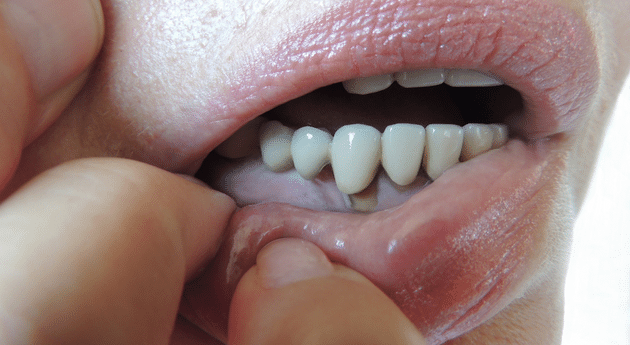PERIODONTAL DISEASE OR PERIODONTOPATHY
GINGIVITIS AND PERIODONTITIS
IN SWITZERLAND, PERIODONTAL DISEASE AFFECTS
MORE THAN 80% OF ADULTS BETWEEN 35 AND 44 YEARS OLD
THESE FIGURES ARE REPORTED BY THE ICSII SURVEY,
CONDUCTED BY THE ADF UNDER THE AEGIS OF WHO
PERIODONTAL DISEASE OR PERIODONTAL DISEASE
GINGIVITIS AND PERIODONTITIS
A DEADLY INFLUENCE IN SYSTEMIC DISEASES
CARDIOVASCULAR AND DURING PREGNANCY
WHAT IS PERIODONTAL DISEASE?
PERIODONTAL DISEASES OR PERIODONTAL DISEASE OR PERIODONTITIS
These are all pathologies that affect the tissues that support the teeth, called periodontium. The four tissues that make up the periodontium are:
- Gum;
- Alveolar bone;
- The alveolar-dental ligament;
- Desmodont and cementum.
When a pathology affects the entire periodontium, it is called periodontitis. If it affects only part of the tissue, specific terms are used (gingivitis when there is inflammation of the gums, alveolysis if there is bone loss).
Periodontal disease is caused by plaque. Dental plaque is made up of a group of microbes including bacteria, viruses, protozoa, and yeast.
Plaque can be removed by maintaining good oral hygiene on a daily basis. Thus, it is possible to avoid and prevent common periodontitis without a genetic cause.
As with gingivitis, there are several classes of periodontal disease:
- Simple periodontitis: horizontal alveolysis.
- Chronic or complex periodontitis: horizontal alveolysis. An aggravating factor is the occlusion.
- Aggressive or rapidly progressing periodontitis: localized or generalized, horizontal and/or vertical alveolysis. An aggravating factor is genetics.
Gingivitis is presented in five classes:
- Classic gingivitis: an inflammation of the gums due to the presence of dental plaque.
- Generalized hypertrophic gingivitis: this is caused by certain medications such as anti-epileptic drugs and certain beta-blockers.
- Localized hypertrophic gingivitis.
- Epulis: frequent in pregnant women, they are due to certain female hormones.
- Ulcero-necrotic gingivitis (UGN): Immunocompromised patients are at risk of developing this type of gingivitis which is characterized by tissue necrosis without pocket formation. This pathology develops following a major stress or a serious illness.
Deadly consequences on the dentition.
Periodontal disease is a bacterial disease that consumes the bone that supports the roots of the teeth. When this anchoring bone tissue is destroyed, it is called loosening of the teeth, which can lead to tooth loss. Periodontal diseases are one of the major causes of edentulism in adults.

TREATMENT OF PERIODONTITIS

The overall principles of periodontal disease care protocols have been clearly established medically for many years and have changed little since then. However, progress in research has been made, particularly on the fabrics used and their application. Progress has been made in the use of synthetic fillers and collagen membranes.
The innovation lies in the global approach of medicalized technical platforms. Today, sedation makes it possible to perform several periodontal procedures at once in the operating room.
These innovative protocols are applied in compliance with current medico-legal obligations. They refine the results of care, since they allow better management of the patient’s anxiety, and thus limit inflammation and bleeding.
In addition, since the treatment time is optimized, the periodontium is less exposed to the air during the operation. The results are less random.
PERIODONTAL TREATMENTS WITHOUT SURGERY
The respect of an impeccable oral hygiene
When caught early, periodontal disease can be treated without the use of invasive treatments.
A rigorous oral hygiene is a prerequisite. The treatments against periodontal diseases will not be effective if this prerequisite is not respected.
Good oral hygiene means brushing your teeth daily (at least twice a day), for three minutes, using a soft-bristled toothbrush, and completing the brushing with dental floss or an interdental brush.
Descaling
Scaling is performed at the dental surgeon’s office. It consists of the removal of tartar accumulated on the teeth with a scaler, a device using ultrasound, or curettes, through a mechanical action.
Root planing
Root planing consists of mechanical disinfection (smoothing or polishing) of the root surface of an area where the gum has become detached. This treatment is performed on the part that is below the gum line of the root surface. It requires only a simple local anesthetic.
SURGICAL TREATMENTS OF THE PERIODONTIUM
If the periodontal pathology is too advanced, a surgical intervention is necessary.
Surgical periodontal treatments are contraindicated in smokers, diabetics with uncontrolled blood sugar levels, and immunocompromised patients.
Periodontal curettage
The dental surgeon creates a flap (a cut in the gum) to gain direct access to the surface of the diseased root. Healing takes longer than after a conventional surfacing.
Bone filling of periodontal pockets
The periodontal pocket may be defective. Bone filling is used to fill this pocket using an allogeneic, xenogeneic, or alloplastic graft. This procedure will allow the patient to gain bone height. The roots of the teeth will be better anchored in the bone.
Guided tissue regeneration ROG
The ROG technique allows the tissue to regenerate using a bone graft. This can be allogenic, xenogenic, or alloplastic. It is associated with collagenous membranes. Thus, the height of the bone is increased and root anchorage is ensured.
The contribution of FRPs and PRPs in the treatment of periodontitis
FRP, Fibrin Rich Plasma, and PRP, Platelet Rich Plasma, provide the growth factors necessary for perfect healing.
YOU ARE UNIQUE!
CLINICAL CASES OF PERIODONTAL DISEASE
TREATMENT OF PERIODONTAL DISEASE



